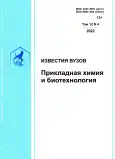Characteristics of composition and content of auxins in tissues of Siberian apple tree Malus baccata L. Borkh.
- Authors: Stolbikova A.V.1, Dudareva L.V.1, Rudikovskii A.V.1, Stavitskaya Z.O.1, Kopytina T.V.1, Rudikovskaya E.G.1
-
Affiliations:
- Siberian Institute of Plant Physiology and Biochemistry, SB RAS
- Issue: Vol 12, No 4 (2022)
- Pages: 620-626
- Section: Brief communication
- URL: https://journals.rcsi.science/2227-2925/article/view/301212
- DOI: https://doi.org/10.21285/2227-2925-2022-12-4-620-626
- ID: 301212
Cite item
Full Text
Abstract
About the authors
A. V. Stolbikova
Siberian Institute of Plant Physiology and Biochemistry, SB RAS
Email: alecsandrit@rambler.ru
L. V. Dudareva
Siberian Institute of Plant Physiology and Biochemistry, SB RAS
Email: laser@sifibr.irk.ru
A. V. Rudikovskii
Siberian Institute of Plant Physiology and Biochemistry, SB RAS
Email: rudikovalex@mail.ru
Z. O. Stavitskaya
Siberian Institute of Plant Physiology and Biochemistry, SB RAS
Email: stavitskaya.zlata@gmail.com
T. V. Kopytina
Siberian Institute of Plant Physiology and Biochemistry, SB RAS
Email: kopytina@mail.ru
E. G. Rudikovskaya
Siberian Institute of Plant Physiology and Biochemistry, SB RAS
Email: rudal69@mail.ru
References
- Pop T. I., Pamfil D. C., Bellini C. Auxin control in the formation of adventitious roots // Notulae Botanicae Horti Agrobotanici Cluj-Napoca. 2011. Vol. 39, no. 1. P. 307−316. https://doi.org/10.15835/nbha39161012011.
- Новикова Г. В., Носов А. В., Степанченко Н. С., Фоменков А. А., Мамаева А. С., Мошков И. Е. Пролиферация клеток растений и ее регуляторы // Физиология растений. 2013. Т. 60. N 4. С. 529–536. 10.7868/S0015330313040118' target='_blank'>https://doi: 10.7868/S0015330313040118.
- Song C., Zhang D., Zhang J., Zheng L., Zhao C., Ma J., et al. Expression analysis of key auxin synthesis, transport, and metabolism genes in different young dwarfing apple trees // Acta Physiologiae Plantarum. 2016. Vol. 38. http://doi.org/10.1007/s11738016-2065-2.
- Bu H., Yu W., Yuan H., Yue P., Wei Y., Wang A. Endogenous auxin content contributes to larger size of apple fruit // Frontiers in Plant Science. 2020. Vol. 11. P. 592540. https://doi.org/10.3389/fpls.2020.592540.
- Su Y., He H., Wang P., Ma Z., Mao J., Chen B. Genome-wide characterization and expression analyses of the auxin/indole-3-acetic acid (Aux/IAA) gene family in apple (Malus domestica) // Gene. 2021. Vol. 768. P. 145302. 10.1016/j.gene.2020.145302' target='_blank'>https://doi: 10.1016/j.gene.2020.145302.
- Singh K. K., Chauhan J. S., Kumar P., Rawat J. M. S., Suwalk R. L. Effect of auxins, rooting media and vegetative propagation methods of apple (Malus spp.) // European Journal of Biotechnology and Bioscience. 2019. Vol. 7, no. 2. P. 82−88.
- Bai T., Dong Z., Xianbo Z. X., Song S., Jiao J., Wang M., et al. Auxin and its interaction with ethylene control adventitious root formation and development in apple rootstock // Frontiers Plant Science. 2020. Vol. 11. P. 574881. https://doi.org/10.3389/fpls.2020.574881.
- Cooper W. C. Hormones in relation to root formation on stem cuttings // Plant Physiology. 1935. Vol. 10. P. 789−794. https://doi.org/10.1104/pp.10.4.789.
- Zimmerman P. W., Wilcoxon F. Several chemical growth substances which cause initiation of roots and other responses in plants // Contributions from Boyce Thompson Institute. 1935. Vol. 7. P. 209−229.
- Mao J.-P., Zhang D., Zhang X., Li K., Liu Z., Meng Y., et al. Effect of exogenous indole-3-butanoic acid (IBA) application on the morphology, hormone status, and gene expression of developing lateral roots in Malus hupehensis // Scientia Horticulturae. 2018. Vol. 232. P. 112−120. https://doi.org/10.1016/J.SCIENTA.2017.12.013.
- Harbage J., Stimart D. P. Effect of pH and 1H-indole-3-butyric acid (IBA) on rooting of apple microcuttings // American Society for Horticultural Science. 1996. Vol. 121, no. 6. P. 1049–1053. https://doi.org/10.21273/JASHS.121.6.1049.
- De Rubel B., Audenaert D., Xuan W., Overvoorde P., Strader L. C., Kepinski S., et al. A role for the root cap in root branching revealed by the non-auxin probe naxillin // Nature Chemical Biology. 2012. Vol. 8, no. 9. P. 798–805. http://doi.org/10.1038/nchembio.1044.
- Blazkova A., Sotta B., Tranvan H., Maldiney R., Bonnet M., Einhorn J., et al. Auxin metabolism and rooting in young and mature clones of Sequoia sempervirens // Physiologia Plantarum. 2006. Vol. 99. P. 73−80. https://doi.org/10.1111/j.1399-3054.1997.tb03433.x.
- Li K., Liang Y., Xing L., Mao J., Liu Z., Dong F., et al. Transcriptome analysis reveals multiple hormones, wounding and sugar signaling pathways mediate adventitious root formation in apple rootstock // International Journal of Molecular Sciences. 2018. Vol. 19, no. 8. P. 2201. https://doi.org/10.3390/ijms19082201.
- Epstein E., Ludwig-Müller J. Indole-3-butyric acid in plants: occurrence, synthesis, metabolism and transport // Physiologia Plantarum. 1993. Vol. 88. P. 382−389. https://doi.org/10.1111/j.1399-3054.1993.tb05513.x.
- Zhao Y. Auxin biosynthesis // The Arabidopsis Book. 2014. Vol. 2014, no. 12. https://doi.org/10.1199/tab.0173.
- Song C., Zhang D., Zheng L., Shen Y., Zuo X., Mao J., et al. Genome-wide identification and expression profiling of the YUCCA gene family in Malus domestica // Scientific Reports. 2020. Vol. 10. P. 10866. http://doi.org/10.1038/s41598-020-66483-y.
- Рудиковский А. В., Рудиковская Е. Г., Дударева Л. В., Кузнецова Е. В. Уникальные и редкие формы яблони сибирской Селенгинского района Бурятии // Сибирский экологический журнал. 2008. Т. 15. N 2. С. 327−333.
- Rudikovskii A. V., Stolbikova A. V., Rudikovskaya E. G., Dudareva L. V. Role of fhytohormones un the formation of dwarf and tall Siberian crabapple (Malus baccata L. Borkh.) // Zemdirbyste-Agriculture. 2019. Vol. 106, no. 2. P. 167−172. http:dx.doi.org/10.13080/z-a.2019.106.022.
- Damodaran S., Strader L. C. Indole 3-butyric acid metabolism and transport in Arabidopsis thaliana // Frontiers in Plant Science. 2019. Vol. 10. P. 851. https://doi.org/10.3389/fpls.2019.008512019.
- Sun C. Y., Wang Y., Xu X. F., Sun Y., Zhu L. H., Han Z. H. Regeneration from leaf segments of in vitro-grown shoots of Malus baccata // New Zealand Journal of Crop and Horticultural Science. 2008. Vol. 36, no. 4. P. 233−238. https://doi.org/10.1080/01140670809510239.
- Михайлова Т. И., Хабаров С. Н. Способы получения корнесобственного посадочного материала яблони для создания устойчивых насаждений // Сибирский вестник сельскохозяйственной науки. 2006. N 2. С. 63−69.
Supplementary files









